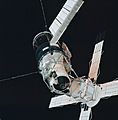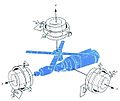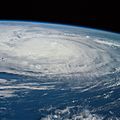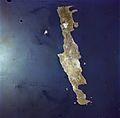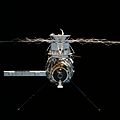Skylab facts for kids
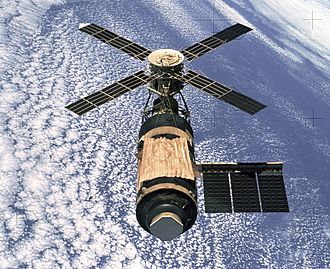
Skylab as photographed by its departing final crew (Skylab 4)
|
|
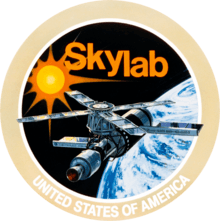
Skylab program insignia
|
|
| Station statistics | |
|---|---|
| COSPAR ID | 1973-027A |
| Call sign | Skylab |
| Crew | 3 per mission (9 total) |
| Launch | May 14, 1973 17:30:00 UTC |
| Carrier rocket | Saturn V |
| Launch pad | Kennedy Space Center LC-39A |
| Reentry | July 11, 1979 16:37:00 UTC near Perth, Australia |
| Mission status | Complete |
| Mass | 170,000 lb (77,000 kg) w/o Apollo CSM |
| Length | 82.4 feet (25.1 m) w/o Apollo CSM |
| Width | 55.8 feet (17.0 m) w/ one solar panel |
| Height | 36.3 feet (11.1 m) w/ telescope mount |
| Diameter | 21.67 feet (6.6 m) |
| Pressurised volume | 12,417 cu ft (351.6 m3) |
| Atmospheric pressure | 5.0 psi (34 kPa) Oxygen 74%, nitrogen 26% |
| Perigee | 269.7 mi (434.0 km) |
| Apogee | 274.6 mi (441.9 km) |
| Orbital inclination | 50° |
| Orbital period | 93.4 min |
| Orbits per day | 15.4 |
| Days in orbit | 2,249 days |
| Days occupied | 171 days |
| No. of orbits | 34,981 |
| Distance travelled | ~890,000,000 mi (1,400,000,000 km) |
| Statistics as of Re-entry July 11, 1979 | |
| Configuration | |
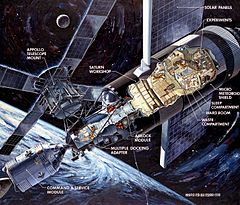
Skylab configuration as planned
|
|
Skylab was the first space station built by the United States. NASA launched it into space in May 1973. Astronauts lived and worked on Skylab for about 24 weeks. Three different crews, each with three astronauts, visited the station. These missions were called SL-2, SL-3, and SL-4.
Skylab was like a science lab in space. It had a workshop, a special telescope to study the Sun, and tools to observe Earth. Astronauts did hundreds of experiments there. Skylab could not be pushed higher into orbit by the Space Shuttle, which was not ready yet. So, in 1979, Skylab fell back into Earth's atmosphere and burned up over the Pacific Ocean.
Contents
What Was Skylab?
Skylab was the only space station ever operated only by the United States. It was a big step for space exploration. Before Skylab, the U.S. had plans for a permanent space station. However, those plans changed. Later, the U.S. joined other countries to build the International Space Station (ISS).
Skylab was launched without a crew. It went into low Earth orbit on a powerful Saturn V rocket. This rocket weighed about 77,000 kilograms (170,000 pounds). The Saturn V rocket was famous for sending astronauts to the Moon. Skylab's launch was the very last time a Saturn V rocket was used.
How Did Astronauts Get to Skylab?
After Skylab was in orbit, three-person crews flew to it. They used the Apollo command and service module (Apollo CSM). This spacecraft was launched by a smaller rocket called the Saturn IB. For the last two missions, NASA even had a backup Apollo CSM and Saturn IB ready. This was in case they needed to rescue astronauts from Skylab. Luckily, this rescue vehicle was never needed.
Skylab's Launch Day Problem
During its launch, Skylab was damaged. A protective shield, meant to stop tiny space rocks, ripped off. This shield also took one of the main solar panels with it. Another solar panel got stuck. This meant Skylab lost most of its electric power. It also lost protection from the Sun's intense heat. The station was in danger of becoming unusable.
The first crew to visit Skylab became heroes. They fixed the problem in space. They put up a new sunshade to keep Skylab cool. They also managed to free the stuck solar panel. This was the first time such a big repair was done in space.
What Was Inside Skylab?
Skylab had several main parts:
- The Apollo Telescope Mount: This was a special observatory to study the Sun.
- A multiple docking adapter: This part had two places where spacecraft could connect.
- An airlock module: This had hatches for extravehicular activity (EVA), also known as spacewalks.
- The orbital workshop: This was the main living and working area for the astronauts.
Skylab got its electricity from solar panels. When an Apollo spacecraft was docked, its fuel cells also provided power. At the back of Skylab, there was a large tank for waste. There were also tanks for fuel to move the station. A radiator helped keep the station cool.
What Did Astronauts Do on Skylab?
Astronauts did many experiments on Skylab. The solar telescope helped scientists learn a lot about the Sun. They took many amazing pictures of Earth. The Earth Resources Experiment Package (EREP) used sensors to study Earth. These sensors recorded data using visible light, infrared, and microwaves.
Skylab also broke records for how long humans could stay in space. The Skylab 4 crew stayed for 84 days. This was much longer than the previous record of 23 days. That record was set by the Soyuz 11 crew on the Salyut 1 space station.
Skylab's Final Days
NASA had hoped to use Skylab again. They wanted the Space Shuttle to visit it and push it higher into orbit. But the Space Shuttle was not ready in time. Skylab's orbit slowly got lower and lower.
Skylab began to fall back to Earth on July 11, 1979. People all over the world watched and wondered where it would land. NASA tried to control its fall. They aimed for the southern Indian Ocean to avoid populated areas. This worked mostly, but some pieces of Skylab landed in Western Australia. The recovered pieces showed that Skylab broke apart lower than expected.
After Skylab, NASA focused on building the Space Shuttle. Later space station projects included Spacelab, Shuttle-Mir, and Space Station Freedom. The Space Station Freedom project eventually became part of the International Space Station.
Images for kids
-
Launch of the modified Saturn V rocket carrying the Skylab space station
-
Owen Garriott performing an EVA in 1973
-
Spider Anita flown aboard Skylab
-
Hurricane Ellen of 1973, as seen from Skylab
-
The island of Crete as photographed on June 22, 1973, from Skylab
-
Skylab Rescue vehicle Apollo CSM being removed from its Saturn IB rocket after the last Skylab mission
-
Fragment of Skylab recovered after its re-entry through Earth's atmosphere, on display at the U.S. Space & Rocket Center
-
The waste disposal equipment in the backup Skylab at the National Air and Space Museum.
-
A mannequin in the backup Skylab at the Smithsonian Institution National Air and Space Museum.
-
Skylab commemorative stamp, issue of 1974. The commemorative stamp reflects initial repairs to the station, including the parasol sunshade.
-
Illustration of Skylab configuration with docked command and service module
-
Space Center Houston Skylab 1-G Trainer mannequin.
-
The main module S-IVB is a section of the Saturn V rocket.
See also
 In Spanish: Skylab para niños
In Spanish: Skylab para niños






